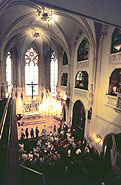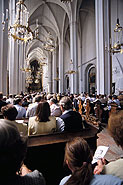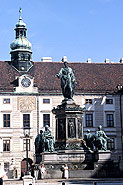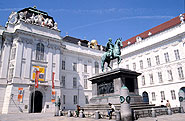
Most European monarchs enjoyed the luxury of both winter and summer palaces. The Hofburg, in the heart of Vienna, was the Habsburg winter palace, which developed into a sprawling complex of buildings over several centuries in which old sections were replaced and new courtyards and wings added. One of the wings today houses the Spanish Riding School with its trained "dancing" Lippizaner horses. The last of the major additions to the Hofburg was completed in the reign of Emperor Franz Joseph I, who also founded the Military History Museum and led the Empire into World War I.

One of the oldest parts of the Hofburg today is the court chapel which retains some of its original fifteenth-century Gothic features. Today it is still an active parish church where on Sundays one can hear the singing of the famous Vienna Choir boys.

Another of the Hofburg's churches is the Augustiner church, built in the first half of the fourteenth century but then later redone in Baroque style. It was restored to its original appearance in the nineteenth century. It was the location of many royal weddings, including that of Maria Theresa. One of its chapels is dedicated to the Loreto Mother of God, the focus of a major Christian shrine in Italy that was particularly revered by the Habsburgs. When members of the Habsburg dynasty died, their bodies would be buried in the Cathedral of St. Stephen, but their hearts would be preserved in the Loreto chapel of the Augustiner church.


One of the elegantly proportioned courtyards of the Hofburg contains a statue to Emperor Franz I, designed by Pompeo Marchesi in 1846. Franz I was the first Emperor of Austria of that name. He began his career as Holy Roman Emperor Franz II, until forced by Napoleon to abandon that title in 1804 when Napoleon defeated the Habsburgs and took for himself the Imperial title. On the base of the statue is a good example of Imperial propaganda, a Latin inscription quoted from the Emperor's will in which he proclaimed his love for his subjects. When Napoleon was finally defeated by a coalition including Russia, Austria, Prussia and England, the peace conference met in Vienna in 1814. During the conference, Russian Emperor Alexander I stayed in the Hofburg in the rooms which would later be the private apartments of Emperor Franz Joseph I. The photo here shows "Alexander's bedroom" in which today are displayed busts of Franz Joseph and his wife.

Another of the Hofburg's courtyards contains a statue of Emperor Joseph II, the son and successor to Maria Theresa who was considered to be one of the most prominent examples of an "Enlightenment" monarch. The statue was designed by Franz Anton Zauner in 1806; the small reliefs around its base depict various enlighted projects of the Emperor. The statue imitates a famous one from Roman times depicting Roman Emperor Marcus Aurelius (who was known as an enlightened philosopher). The backdrop to the statue is one of the important Viennese buildings designed by the famous architect Fischer von Erlach in the eighteenth century; the square is one of the most beautiful architectectural ensembles in the Hofburg.